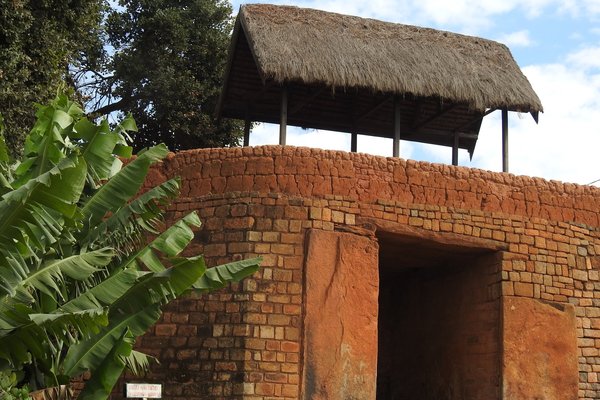Madagascar
Ambohimanga
The Royal Hill of Ambohimanga is an archeological site that contains a ruined city, burial sites, and various sacred places.
Ambohimanga dates from the 16th century and developed into the capital city in the 18th century. The walled city, with stone gates, three palaces, cemeteries and holy places, combines Malagasy and European architectural styles. The hill is also covered with sacred groves, a sacred lake and agricultural terraces. It is still a place of pilgrimage for the local population for the worship of kings and ancestors.
Community Perspective: The site is an easy half-day trip from the capital and is "beautifully set in green countryside looking over a rice paddy filled plain reaching back to Tana". The standard visit includes a guided tour of the royal compound, but it is possible to do a separate 2-hour tour of the sacred forest as well.
Site Info
Official Information
- Full Name
- Royal Hill of Ambohimanga (ID: 950)
- Country
- Madagascar
- Status
-
Inscribed 2001
Site history
History of Ambohimanga
- 2001: Inscribed
- Inscribed
- Type
- Cultural
- Criteria
- iii
- iv
- vi
Links
- UNESCO
- whc.unesco.org
All Links
UNESCO.org
- whc.unesco.org — whc.unesco.org/
News Article
- March 26, 2012 africareview.com — Cyclone devastates historical site Ambohimanga
Community Information
- Community Category
- Secular structure: Palace
- Cultural Landscape: Associative
Travel Information
Recent Connections
-
Austronesian cultures
Malagasy
-
Perfect Inscriptions
2001 -
Ancestor Worship
"The landscape of the Royal Hill of Amb…
Connections of Ambohimanga
- Trivia
-
-
On Banknotes
On the 500 Ariary note -
Built or owned by French
French garrison
-
- History
-
-
African Kingdoms
Merina Kingdom (1540 - 1897)See en.wikipedia.org
-
Queens and Empresses
Queen Ranavalona II (1829 -83) "The Two Pavilions of Queen Ranavalona II The two ornate palace buildings constructed within the compound were built of rosewood in 1871. The first and larger of the two features a room for receiving visitors and a large salon on the ground floor, and the bedroom of Queen Ranavalona II on the second floor. " (Wiki) -
Forbidden City
Ambohimanga was henceforth considered one of the sacred royal hills of Imerina (the Merina kingdom) and was known as a "forbidden city" until 1897. -
Located in a Former Capital
Madagascar 1710-1787
-
- Ecology
-
-
Notable Trees
"The royal trees are species of Ficus and Draceana sp., specifically reserved to royal cities, apparently since 1540." (AB ev)
-
- Damaged
-
-
Destroyed by Hurricanes or Typhoons
"Cyclone Giovanna, which passed over Madagascar in February 2012, caused considerable damage at the site. The wooden shingles of Andrianampoinimerina's house were torn off by the wind, exposing the historic objects inside to damage from the elements. The wooden fence surrounding the Mahandrihono compound was also badly damaged. Worst affected are the plants and trees at the site. Large swaths of endemic medicinal plants and trees in the forest were destroyed. Many of the sacred trees shading the royal city were uprooted, including sacred fig trees around the Fidasiana courtyard and inside the zebu pen. Two of the uprooted trees were of particular symbolic significance, having served as physical anchors for certain royal rituals since the 17th century." (wiki)
-
- World Heritage Process
-
-
Perfect Inscriptions
2001
-
- Religion and Belief
-
-
Holiest place
holiest place for the Malagasi people -
Living indigenous religions
The Royal Hill of Ambohimanga is an exceptional example of a place where, over centuries, common human experience has been focused in memory, ritual and prayer (AB ev, Crit vi) -
Ancestor Worship
"The landscape of the Royal Hill of Ambohimanga is associated ... with traditions and living beliefs having an Outstanding Universal Value (ancestor worship)." (OUV intro) -
Sacred Forests or Groves
"sacred woods consist of indigenous plants and, in a manner now absolutely rare on the Hautes Terres, represents in residual form the natural forest which once covered this and other hills"
-
- Human Activity
-
-
Austronesian cultures
Malagasy
-
Man-made Terraces
"Agricultural terraces were also constructed on the lower hill-slopes." (AB ev)
-
- Constructions
-
-
Baths
Two large basins have been carved from the stone foundation of the compound. One was a bath for Andrianampoinimerina, and the other was a swimming pool for Ranavalona I. Water was taken from the sacred lake of Amparihy at the north of the village and was replaced weekly." Wiki The holy lake of Amparihy is artificial, its use being confined to royalty and ritual, such as the annual royal bath, princely circumcision, and the receipt of royal entrails. The bath is particularly symbolic, for then the king takes upon himself all the sins of the kingdom and, in ritually cleansing himself, both purifies his subjects and enables nature to regenerate." Nom File -
Dynastic Burial Places
Used to be the location for the Merina Dynastic Tombs (the mortal remains were transferred in 1897 by the French, but that didn't reduce the holiness of the site for the Malagasy people)
-
- WHS on Other Lists
- Timeline
-
-
Built in the 16th century
representative of the social and political structure of Malagasy society from at least the 16th century (AB ev)
-
- Visiting conditions
-
-
Foreigner prices
10,000 ariary for foreigners and 400 ariary for locals
-
News
- africareview.com 03/26/2012
- Cyclone devastates historical site…
Recent Visitors
Visitors of Ambohimanga
- AC
- alex
- Alexander Lehmann
- Atila Ege
- Bram de Bruin
- Corinne Vail
- David Marton
- Dennis Nicklaus
- Els Slots
- Eva Kisgyorgy
- Fan Yibo
- Gernot
- Harry Mitsidis
- hivander385
- Iain Jackson
- Janos
- jballard650
- Justin Rickey
- jxrocky
- KarenBMoore
- Knut
- Krijn
- Loic Pedras
- Lucio
- Luis Filipe Gaspar
- marcel staron
- Marcobrey
- Michael Ayers
- Michael Novins
- Mikan22
- Morodhi
- Nihal Ege
- Olli-Pekka Turunen
- PabloNorte
- Paul Schofield
- Philipp Leu
- Randi Thomsen
- Rosemary
- Solivagant
- Stanislaw Warwas
- Svein Elias
- Szucs Tamas
- Thomas Buechler
- Thomas van der Walt
- Timothy C Easton
- Wojciech Fedoruk
Community Reviews
Show full reviews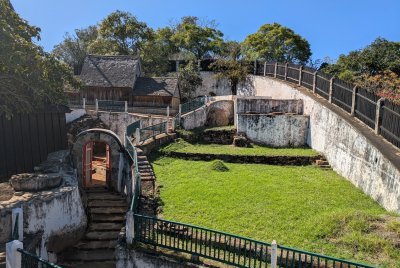
Ambohimanga is one of those places I probably wouldn't have bothered to visit if it weren't a WHS. But I'm very glad I did because, the visit, combined with a visit to the Queen's Palace in Tana, gave me a much better understanding of Madagascar's pre-colonial history. I had a private driver to take me to the Royal Hill of Ambohimanga, about an hour outside of Tana. It's not a huge site, you can spend about an hour there. One there, I picked up a guide at the entrance who spoke very good english. She was very informative. After a brief overview of the fortress from the ceremonial courtyard, and the large sacrificial stone where zebu were sacrificed, we proceeded inside the complex. One of the most interesting buildings is the King's Palace, which was the house of King Andrianampoinimerina who reigned 1787-1810. It's a very modest wooden house. Inside, my guide did a nice job of explaining the various implements on display, as well as explaining the sleeping arrangements, and how the king's bed was always in the one corner, and higher up than where his wife would sleep. He (and subsequent rulers here) didn't rule all of Madagascar, but they did unify many kingdoms in the center/east and established 12 royal residences on nearby hilltops, including the Queen's Palace in Antananarivo. There's also a Queen's palace here at Ambohimanga, a more European looking wooden structure that was the house of Queen Ranavalona I. There's a bit of evidence …
Keep reading 0 comments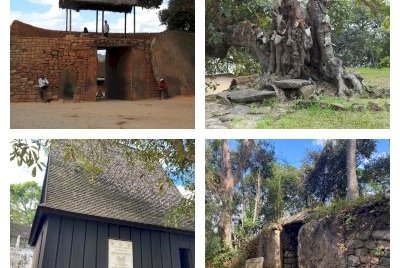
The Royal Hill of Ambohimanga is a fortified hill with great historical and symbolic value for the people of Madagascar. It is a wonderful site to visit as it is in good condition and has so many layers: the first unified Malagasy kingdom, the start of its interaction with the outside world just before colonial times, and a contemporary place of worship. I spent 3 hours there on a guided tour of the palace complex and a forest walk.
Although it lies only 20km away from the Madagascar capital Antananarivo, it will take the best part of an hour to get there by car. Leaving the busy city center is the hardest, after that, a fine drive along the rice paddies follows. Ambohimanga is one of many hills in this area. From viewpoints, you can also see the tomb of the King’s astrologer on the adjacent, slightly higher hill. Also, there are the remains of a palace in between these two hills. The astrologer’s hill is a popular place for local worship, the only way to get there is to walk up.
We started the visit to Ambohimanga after entering via the Royal Gate. Local nobility started using this hilltop from the 15th century on, but most of what you now see dates from the early 19th century. The Malagasy royals were a promiscuous bunch, the guide told stories about the Queen that had all her lovers killed or the Prime Minister that ended up marrying three of …
Keep reading 0 comments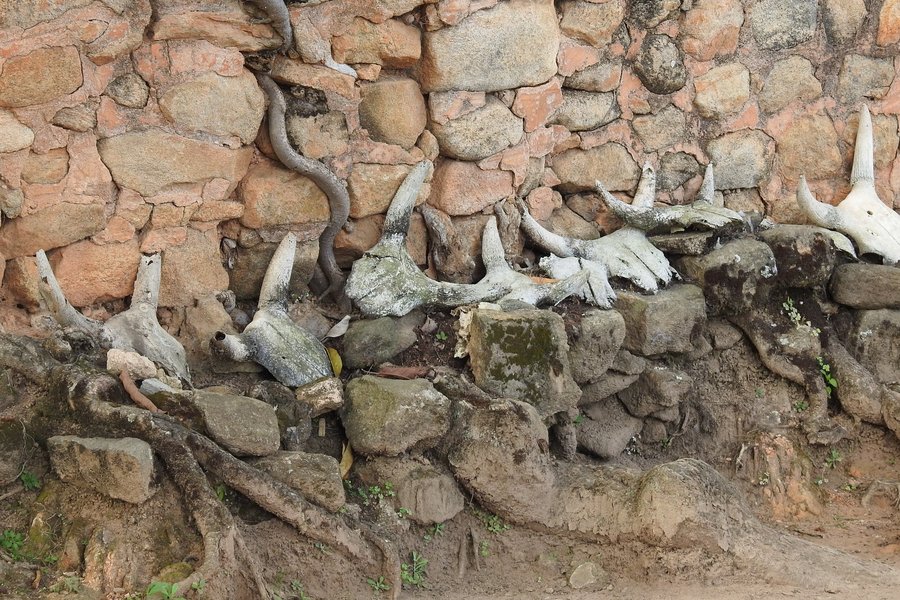
a visit to the royal palace compound of Ambohimanga will give you a perfect introduction to the Malagasy history and its an easy half day excursion from the capital.The first impression are the huge fig trees at the ceremonial courtyard.this is still a sacred place for Malagasy people and
rituals take place on a daily basis.During the reign of the kings, mainly brown checkered Zebu cows were brought to the royal stables as offerings..nowadays its more on chicken, I was told. Once inside the royal compound, you will be shown the wooden house of the great king Andrianampoinimerina who.. reigned from 1787 to 1810.His majesty used to sleep much higher up than his 12 wifes who had to share one bed on those special days that they all came together to the royal palace from the neighbouring 12 hills. I was also told by the guide that High land people used to be much smaller at that time as there was more Asian than African influence.Therefore the 12 queens could share one single bed!Next to the kings house stands the summer house of the queens, Ranavalona I. reigned long 33 years and she was using this place as a retreat from Antananarivo where the capital has been moved to.With her was her French lover and architect Jean Laborde who was about the only foreign national admired by the queen, until 1847 when also Laborde was expelled because of his involvement in a plot to replace the queen with her son.Behind …
Keep reading 0 comments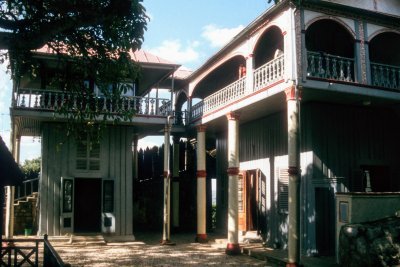
If you are in Madagascar then, as was ours in April 2000, your prime objective is probably to see Lemur and the other unique ecological aspects of the country . However, the Malagasy history and culture is interesting too having developed from the first immigrants – coming, not from Africa, but some 1500 years ago from the area of present day Indonesia and Malaysia. Meeting the people and seeing their way of life and rituals/ritual objects is also a major plus point for the country.
Ambohimanga, the main “historic site”, is only 20 kms from the capital and should NOT be missed whilst you are there. By the time the British and French vied for control over Madagsacar in the 19th century Madagascar was ruled by a royal line of the Merina clan who came from the highland area around Antananarivo. Ambohimanga was their Palace and later, as Antananarivo became the capital, it in developed as the weekend retreat for the royal family.
The place has a peaceful atmosphere made more poignant by the history of what happened to the royal family who used it. In 1890 the British eventually gave way to the French in return for a free hand in Zanzibar and the French invaded Madagsacar in 1895 eventually deposing the Queen and exiling her to Algeria. The family was never allowed to return by the French.
The compound is beautifully set in green countryside looking over a rice paddy filled plain reaching back to …
Keep reading 0 comments
